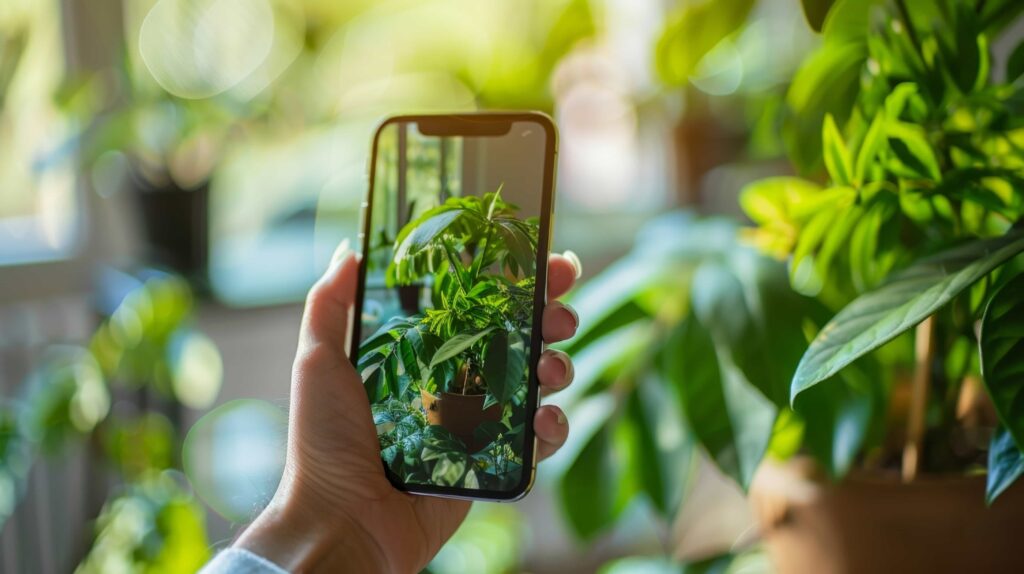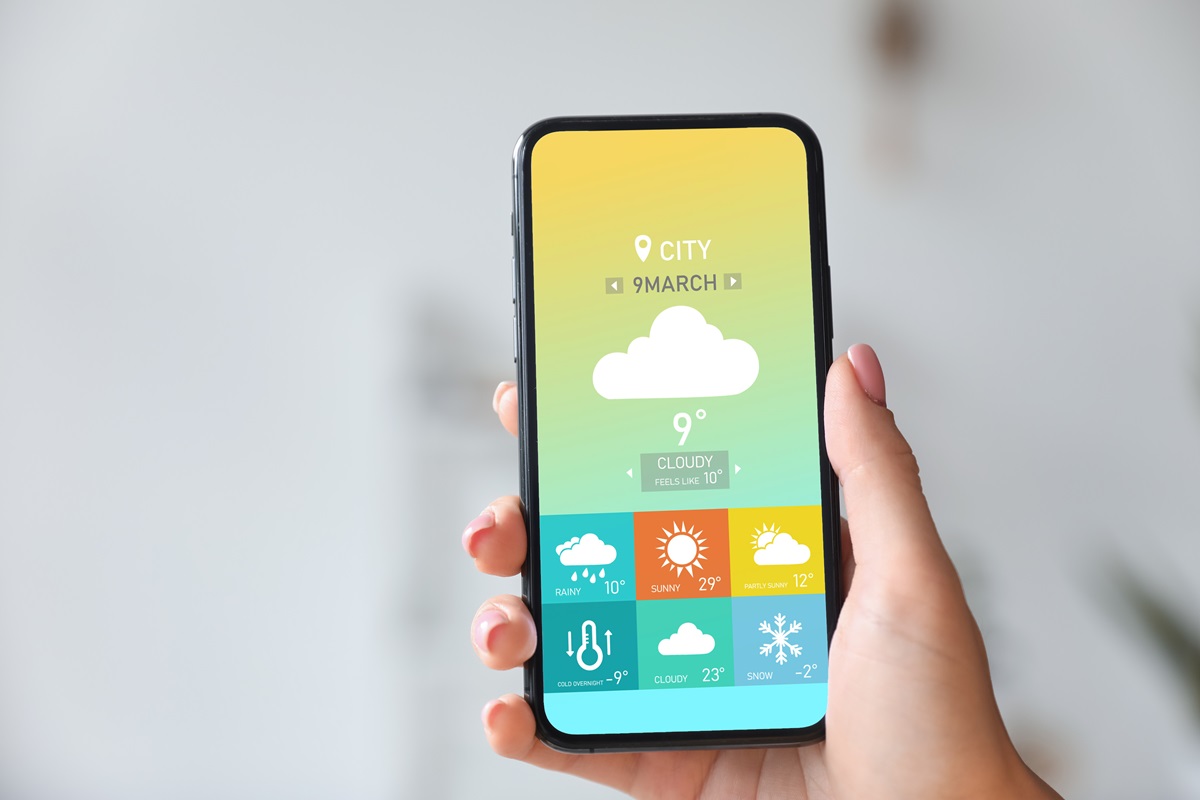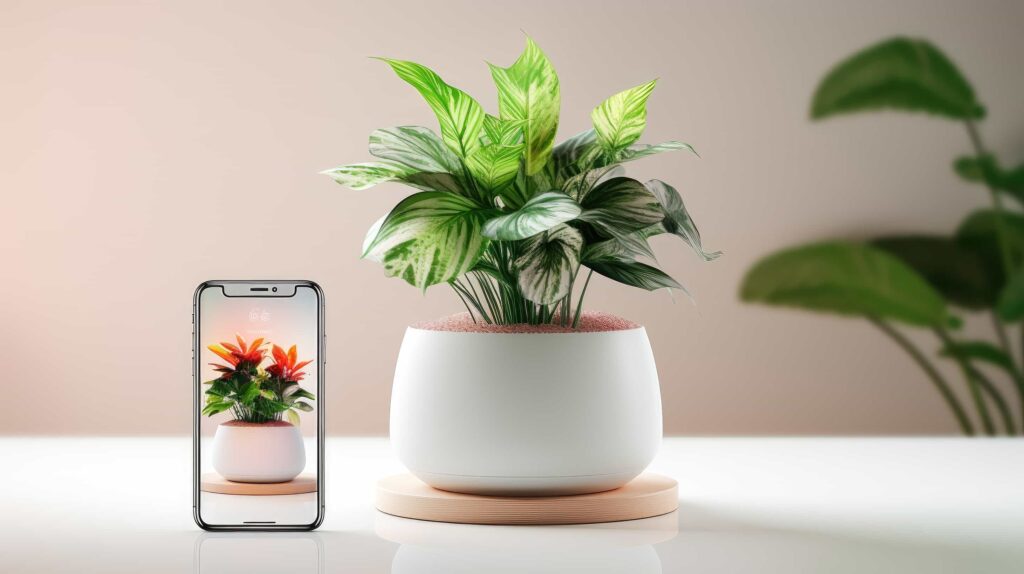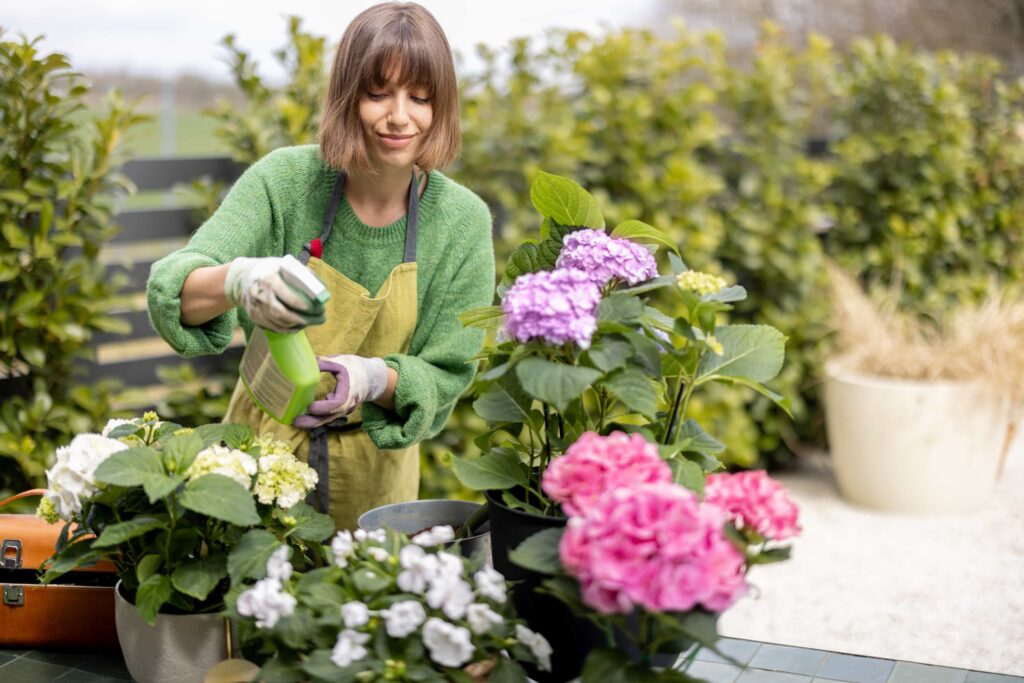Grow your garden with the best apps

Introducing plant care may seem like a challenge, but with the help of specialized apps, this task becomes more accessible and organized.

Weather Forecast Apps
Explore the world of weather apps: from global forecast models to customizable alerts.
Let's explore the best apps for caring for plants, which offer practical features to make your gardening routine easier.
Best apps for taking care of plants
Nowadays, there are several gardening apps that help with everything from identifying species to monitoring watering and pruning.
Check out some of the most recommended ones:
PlantSnap
PlantSnap is a powerful tool for instantly identifying plants.
Just take a photo and the app returns detailed information about the plant, its needs and specific care.
This app is ideal for those who want to learn more about the species in their garden and even explore new plants outdoors.
- Platforms: Available for Android and iOS.
- Paid or free: Free with paid options for additional features.
Plantix
Focused on plant health, Plantix helps identify pests and diseases through photos, as well as suggesting effective treatments.
The app is perfect for those looking to keep their garden healthy and protected against common threats.
- Platforms: Android.
- Paid or free: Free with some premium features.
Blossom
With an extensive database, Blossom provides detailed information about each plant, from water requirements to light and ideal soil type.
The app helps both beginners and experienced gardeners to better care for their plants.
- Platforms: Android and iOS.
- Paid or free: Free with paid version for extra features.
PictureThis
PictureThis is known for its active community of users, which makes it easy to share gardening information and experiences.
Additionally, it offers a photo-based plant identification system and detailed care tips.
- Platforms: Android and iOS.
- Paid or free: Free with subscription options.
Tips for getting the most out of your gardening app
Using gardening apps requires more than just downloading the app and registering your plants. Here are some strategies to maximize the use of these apps:
- Customize notifications: Set up alerts for watering, fertilizing and pruning. This helps you not to miss the right time for each care.
- Photograph your plants regularly: Monitor growth and notice potential problems. Photos help identify changes in plant health.
- Take advantage of extra features: Many apps offer tips and communities. Participating in these areas is a great way to learn new practices and resolve doubts.
- Adapt the use of the app to your space: If you have indoor plants, focus on the tips for indoor environments. If it’s an outdoor garden, take advantage of the advice on sun and wind.
- Integrate the app with your routine: Try using the app at fixed times of the day, making it easier to adapt plant care to your routine.

How to Edit Photos on Your Cell Phone
Learn how to edit photos on your cell phone! Tips and apps to transform your images into true works of art.
What to Consider When Choosing a Plant App
Choosing the ideal plant care app depends on your goals and the features you value.
Each application has specific features, and understanding what you expect from it will help you make a more assertive decision.
Before choosing, consider the type of plants you grow and their maintenance needs, such as watering, light, and nutrition.
This will ensure that the app has relevant tools to make your care routine easier.
- Set your gardening goals: Consider whether you’re just looking to monitor your plants or whether you need more detailed monitoring. Some apps focus on simple tasks, while others provide more complex analysis, such as pest diagnosis.
- Consider the level of gardening knowledge: Apps like PlantSnap and Blossom are recommended for beginners, as they have an intuitive interface and easy instructions. On the other hand, advanced users can opt for apps with more complete and interactive features.
- Basic and advanced features: Check if the app has reminders for watering, pest diagnosis and growth monitoring. These features are essential for those who want to maintain efficient control.
- Community and support: Some apps offer a community where users can share tips and resolve questions with other gardeners. This is a valuable resource for those looking to improve their gardening skills.
- Customization options: Apps that allow you to set reminders and adjust information according to the specificities of each plant make care more efficient and personalized.
- Free or paid: Many gardening apps are free, but offer paid plans with additional features. Consider what each version offers and whether the investment is necessary for your goals.
How to identify the needs of each plant?
Understanding the specific needs of each plant is essential to providing adequate care.
Each species has its own requirements, and failure to pay attention to these details can compromise the health of the plants.
Observing and interpreting the signs that plants show helps to create a more effective and personalized routine.
Some tips to identify your plants' needs:
- Observe the color and texture of the leaves: Yellow, wilted, or spotted leaves indicate potential problems. Yellowing usually means a lack of nutrients or light, while wilted leaves can point to too much or too little water.
- Feel the ground frequently: Soil indicates the need for water and nutrients. Check the texture and moisture; dry soil means it's time to water, while soggy soil can suffocate roots and cause disease.
- Evaluate the amount of light: Many plants need direct sunlight to thrive, but some species do better in the shade. Place them in suitable locations and see how they respond.
- Record the changes: Using an app to record the progress of each plant can help identify patterns and adjust care based on observed responses.
- Adjust the environment according to the plan: If indoor plants are showing limited growth, consider factors such as ventilation and humidity. Adjust their environment or position if necessary.
Common mistakes when caring for plants and how to avoid them

Many plant care mistakes are avoidable, but some of them can seriously compromise the health of your plants.
Knowing these mistakes and learning how to avoid them is essential to ensuring the success of your gardening routine.
Here are some of the most common mistakes and how to avoid them:
- Over or under watering: Improper watering is one of the most common mistakes. Too little water leaves plants dry, while too much can rot the roots. Use an app to create watering reminders and keep track of soil moisture.
- Incorrect light exposure: Light is a crucial factor for plant growth. Plants that require direct light may have their development impaired if they are placed in shaded areas. Position each plant according to its specific needs.
- Improper use of fertilizers: Many beginner gardeners tend to overdo fertilizers, which can overwhelm plants. Use appropriate fertilizers and follow the recommended frequency and amount.
- Ignoring signs of pests and diseases: Pests and diseases are a constant threat. Keep an eye out for signs like spots or bitten leaves. Some apps can help you identify and combat these problems.
- Lack of pruning: Pruning is necessary for the maintenance of many plants. Ignoring it can lead to uncontrolled growth and a buildup of dead leaves, which can affect the health of the plant. Prune regularly to encourage healthy growth.
- Not using a monitoring system: A gardening finance tracking app helps you keep an overview of your plants' health and organize reminders for all tasks.
How to adapt care according to the seasons?
The climate directly influences the health of plants, and adjusting care according to the seasons is essential to ensure that they remain healthy throughout the year.
Each season requires specific adaptations to your gardening routine, and with the help of apps, it is possible to maintain an ideal schedule.
Tips for adjusting plant care throughout the year:
- Spring: In spring, plants begin to grow. Gradually increase the amount of water and start applying fertilizers to stimulate growth. Keep plants in a location with good light to promote healthy growth.
- Summer: The intense summer heat requires more frequent watering and greater protection from the sun. Avoid watering during the hottest part of the day and place plants in partial shade if necessary.
- Fall: In the fall, many plants begin to slow down their growth. Reducing watering and fertilizing helps prepare them for winter. It’s also a good time to prune dead branches and clear the soil to keep pests out.
- Winter: In winter, plants need special care. Watering should be reduced, as the soil dries out more slowly. Place plants near windows to ensure good exposure to natural light and keep them protected from cold winds.
Using an app to set seasonal reminders can help you maintain a proper care routine throughout the year, ensuring your plants thrive in every season.
Benefits of monitoring plant growth
Monitoring plant growth is a fundamental practice for maintaining the health of your garden.
Monitoring development allows you to identify problems in the early stages and adjust care according to the specific needs of each plant.
This ongoing monitoring helps create a healthier environment and ensure your plants are getting the nutrients and attention they need to grow in a balanced way.
Regular monitoring also allows you to notice seasonal changes and adaptations according to the climate and environment.
Using apps, it is possible to record data on growth, identify patterns and act preventively in case of signs of stress or illness.
This process makes plant care more organized and efficient, especially for those who have several species with different needs.
- Photograph periodically: Take photos of your plants at regular intervals to compare growth and notice details that might otherwise go unnoticed.
- Use a gardening journal: Record information about watering, fertilization and pruning in a specific app or notebook to identify patterns and adjust care.
- Observe the changes in the leaves: Changes in leaf color or texture can indicate problems. By monitoring regularly, it's easier to act quickly.
- Evaluate the height and diameter of the stems: Growth can indicate whether the plant is getting enough light or whether it needs more nutrients.
- Adjust watering according to development: Growing plants often need more water and nutrients. Make adjustments based on your observations.
How to understand the signs that your plant is not healthy
Plants show clear signs when they are in trouble, and knowing how to interpret these signs is crucial to maintaining a healthy garden.
Identifying changes in leaves, stems, and soil can help correct the problem before it gets worse.
Problems are often related to factors such as inadequate watering, lack of nutrients or insufficient exposure to light.
Knowing the signs that a plant is not healthy is the first step in providing proper care.
With the help of an app, you can record these observations and compare them with available information, obtaining a faster and more effective response.
Plants react to their environment, and careful monitoring ensures that necessary adjustments are made to avoid major problems.
Tips for identifying plant problems:
- Yellowed leaves: Yellow leaves usually indicate overwatering or a lack of nutrients, such as nitrogen. Adjust watering or consider a suitable fertilizer.
- Slow growth: Lack of light is one of the main causes of slow growth. Check the position of the plant and the amount of light it receives.
- Wilted or fallen leaves: Too much or too little water can cause this problem. Test the soil moisture and adjust the frequency of watering.
- Leaf spots: Brown or black spots can be signs of disease or pest infestation. Isolating the plant can prevent the problem from spreading.
- Soil with unpleasant smell: Soggy soil can create a breeding ground for fungus, which can harm roots. Check drainage and adjust watering.
What are the essential nutrients for plants and how can we ensure that they receive them?
Plants need a series of nutrients to grow in a healthy and balanced way.
Among the essential nutrients, nitrogen, phosphorus and potassium stand out, which are fundamental for the development of leaves, flowers and roots.
In addition to these, micronutrients such as calcium, magnesium and iron are also necessary to maintain plant health.
Ensuring that your plants receive all the nutrients they need is essential for good development.
Inadequate nutrition can lead to deficiencies, which manifest in visible symptoms such as discolored leaves or uneven growth.
It is possible to provide the necessary nutrients with specific fertilizers, in addition to paying attention to the type of soil and the amount of light and water.
Main nutrients and how to ensure balance in nutrition:
- Nitrogen: Nitrogen is essential for leaf development and is required for photosynthesis. Use nitrogen-rich fertilizers for plants that require strong leaves.
- Match: Important for root growth and flowering. Phosphorus fertilizers help stimulate flower and fruit formation.
- Potassium: It contributes to plant resistance and strengthens the immune system. Potassium is important for plants exposed to adverse weather conditions.
- Calcium and magnesium: These micronutrients aid in the formation of cell walls and photosynthesis. Acidic soils may need a supplement to balance these nutrients.
- Check the soil pH: Improper pH often prevents plants from absorbing nutrients, even if they are present. Test your soil regularly.
How to organize your garden to make care easier?

The arrangement of plants in the garden or indoors is essential to optimise space and facilitate routine maintenance.
A well-organized garden helps ensure that each plant receives the ideal amount of light and allows you to have easy access for watering, pruning, and other care.
Planning the arrangement of plants also prevents uncontrolled growth and makes the environment more visually pleasing.
For those who grow plants indoors, organization also influences access to natural light and ventilation.
It is important to position each plant according to its needs, avoiding grouping species that require opposite conditions.
An efficient layout not only makes care easier, but also contributes to the healthy development of the entire garden.
- Group plants with similar needs together: Group plants that require the same amount of light and water, which makes watering and proper exposure easier.
- Consider the height of the plants: Taller plants can shade smaller ones. Arrange them in layers, placing larger plants at the back.
- Use shelves or stands for indoor plants: This organization helps to make better use of space and ensures that each plant receives the light it needs.
- Keep plants easily accessible: Place plants that require frequent care in easy-to-reach locations, making routine maintenance easier.
- Avoid excessive crowds: Leave space between plants to ensure adequate ventilation and reduce the risk of pests and diseases.
The importance of light for plant health and how to ensure the ideal amount
Light is one of the most important elements for plant health. It plays a crucial role in photosynthesis, the process in which plants convert light into energy to grow.
Without enough light, plants cannot produce the energy needed to grow, which results in yellow leaves, slow growth, and even plant death.
Therefore, ensuring that each plant receives the ideal amount of light is essential for its healthy development.
Each type of plant has a specific light requirement. Plants that thrive in full sun, such as succulents and cacti, need direct sunlight for several hours a day.
Shade plants, such as ferns and peace lilies, prefer indirect light or partial shade.
Using a gardening app can help identify these needs, providing guidance on the ideal amount of light for each species.
Additionally, natural light can vary depending on the environment, so it is important to position plants in strategic locations.
For those who grow indoors, artificial light can complement natural light.
Grow lights, which mimic sunlight, are a great option for plants that don't get enough light indoors.
These lamps can be programmed to maintain an ideal light cycle, helping the plant photosynthesize and grow healthily.
How to Create a Healthy Environment for Your Indoor Plants
Creating a suitable environment for plants in indoor spaces requires care with factors such as light, ventilation and humidity.
These elements are essential for healthy growth, as indoor environments tend to be more controlled and present specific challenges.
To help plants thrive indoors, it's important to replicate the conditions they would experience in their natural environment.
Ventilation is an aspect that is often overlooked, but it is essential to avoid the accumulation of moisture and prevent the appearance of fungi.
Indoors, keeping the air circulating, either with open windows or using fans, helps maintain a healthy environment for plants.
Additionally, humidity control is crucial, especially for plants that require higher humidity, such as ferns and calatheas.
Choosing the location is also important. Placing plants near windows ensures that they receive natural light, but it is important to observe the type of light that enters the room (direct or indirect) and whether it is suitable for each species.
Tips for creating a healthy environment for indoor plants:
- Adjust humidity according to the species: Use humidifiers or spray water on the leaves, especially on tropical plants that like humidity.
- Ventilate the environment regularly: Open windows or use fans to prevent moisture build-up and improve air circulation.
- Control the temperature: Keep the room temperature between 18-24°C, the ideal range for most plants.
- Avoid sudden changes: Moving plants frequently can cause stress. Find the ideal spot and keep them there.
- Use artificial light when necessary: For plants that don't get enough light, invest in grow lights.
Tips for choosing the right pots and soil for each type of plant
Choosing the right pot and soil for each plant is essential to ensure its healthy growth.
The right pot allows roots to develop and prevents water accumulation, while the soil provides the ideal nutrients and texture for each type of plant.
The combination of a well-chosen pot and appropriate soil creates the perfect environment for the plant to grow healthily.
Pots with good drainage, for example, are essential for plants that do not tolerate excess moisture, such as cacti and succulents.
For these plants, it is important to choose a pot with holes in the bottom, allowing excess water to drain.
Plants that need more humidity, such as tropical plants, can benefit from humidity-controlled pots, which help retain water without becoming waterlogged.
The choice of soil is also essential. Sandy soils, for example, are recommended for succulents, as they allow for fast drainage.
Soils that are rich in organic matter and slightly denser are ideal for tropical plants, which like humidity. Using the right soil helps the plant absorb nutrients better and grow healthily.
Apps to listen to free music
For those who enjoy gardening, good music can make the experience even more enjoyable.
Tending to your plants while listening to your favorite music can help create a relaxing environment, promoting well-being for you while you tend to your garden.
Furthermore, several studies indicate that sound can positively influence plant growth.
Nowadays, there are many apps for listening to free music, which offer personalized playlists for all tastes.
If you are interested in finding out which are the best apps for listening to free music, take a look at our next article.
In addition to ready-made playlists, some of these apps offer instrumental music and nature sounds that can harmonize well with plant care.
Stay tuned for our next article and explore the best music apps to make gardening even more enjoyable!

The Most Popular Apps to Listen to Free Music
Want to listen to music without paying? Check out our list of the best apps to listen to music for free, offline and without ads!

